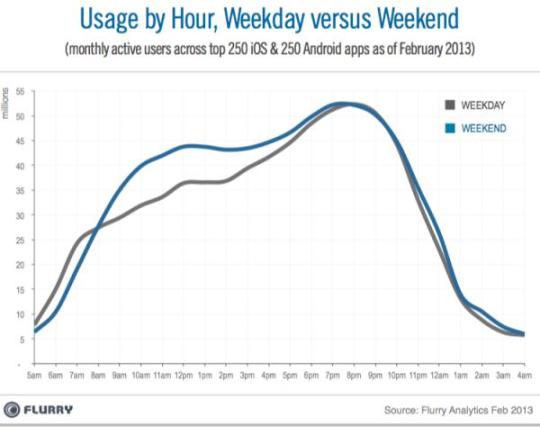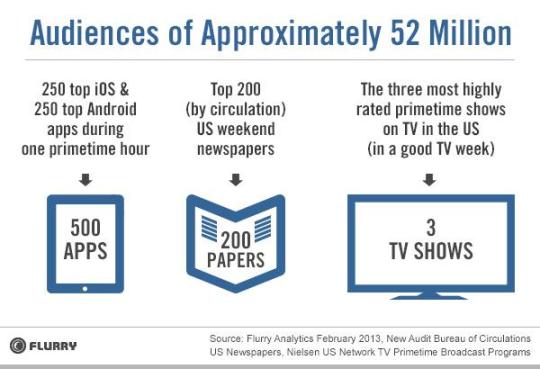Flurry now measures apps used on more than 1 billion smartphones and tablets each month. As connected devices reach critical mass, marketers are more seriously incorporating mobile into the marketing mix. But there are pros and cons. While the collective size of the mobile audience is rivaling that of TV and other media, it still requires aggregating the audiences of many apps to reach what can be reached through a few TV programs. That said, the numbers are likely closer than you think. Additionally, mobile offers unique ways to engage consumers given its “always on, always present” characteristics.
In this report, we look into what it takes to reach comparably sized audiences across different media like television, print, online and mobile apps. We also drill down into how the size and engagement of the mobile app audience varies across days of the week and hours of the day, and how it presents unique opportunities.
Let’s start by considering when people use apps.

The chart above shows how app usage varies over the course of a day, cut by weekend versus weekday. Data used for this chart comes from the top 250 iOS and top 250 Android apps measured by Flurry Analytics during February 2013. Through the top apps Flurry sees, app usage spikes during primetime to a peak of 52 million consumers. Make a mental note of that number, because we’ll revisit it a little later.
Comparing weekday to weekend curves, the general shape is similar. App usage ebbs overnight and then grows throughout the day, peaking in the early evening. While weekends also have a distinct primetime window, they see higher daytime usage across the day between 9:00 AM – 5:00 PM, ostensibly when someone would normally be working. However, the overall difference in audience size during the day between weekdays and weekends is not substantially different. Let’s look at 11:00 AM, for example, when the number of people using apps varies the most between weekdays and weekends. The size of the audience during this time is only 25% greater on weekends. Looking at it another way, this means that during the normal workday, people use apps at least 75% as much as they do on weekends. This creates a unique opportunity for advertisers to reach desired audiences over the course of the day via mobile.
Now, let’s return to that 52 million primetime app user number. To get to an audience of that size, you’d need to combine the circulation of the largest 200 weekend newspapers in the U.S. or combine the audiences for the 3 most highly rated primetime TV shows during a good TV week (e.g., The Big Bang Theory).

We believe this comparison says a couple of important things about the app audience: first that it has reached critical mass, and second that it is still highly fragmented relative to more traditional forms of media. Additionally, while we don’t compare costs in this study, it is far more affordable to reach an audience on mobile versus Print or TV.
Now let’s consider how the app audience compares to the audience that is reachable through larger digital devices like laptops and computers. Flurry measured 224 million monthly active users of mobile apps in the United States in February of this year. During the same month, comScorecounted 221 million desktop and laptop users of the top 50 digital properties in the United States. From this, we conclude that the U.S. audience that is reachable through apps, albeit more fragmented, is now roughly equal to that which can be reached on laptops and desktops.
Earlier this year, Morgan Stanley analyst Benjamin Swinburne showed that “There has been a 50 percent collapse in broadcast TV audience ratings since 2002.” As the prized 18 – 49 year old demo is further lured to digital media, marketers need to adjust. But the mobile industry also needs to do more to make media planning and buying more efficient for advertisers and agencies.
The more mobile ad networks increase their ability to deliver the right combination of reach and targeting, the easier it will be for advertisers to invest in mobile and leverage the unique value it offers. Mobile, in particular, can deliver different ads to different users within the same app or the same ad to similar types of people across different apps, based on the varying interests of those individuals. Dynamic segmentation is much more possible on mobile compared to earlier forms of broadcast media. Now, fast forward one year from now, by which time Flurry estimates the installed base of smartphones and tablets will have doubled to 2 billion active devices per month. That should leave marketers of nearly every product thinking: on mobile, there’s an audience for that.